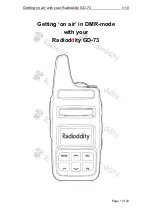
The RF portion of this network requires no changes to the hardware settings described in the
previous procedure.
See the
Konect Pakbus Router Getting Started Guide
for more information on setting up that
part of the network.
B.3 Computer-to-RF network with parallel
repeaters (using SubNet ID)
In this example, the gateway radio is connected to a computer running
LoggerNet
(see
[p. 36] and
[p. 36]). One stand-alone repeater (Repeater 1) is used to access several
endpoint radios connected to data loggers in the field. The stand-alone repeater consists of an
RF451/RF452, power supply, and antenna. Another repeater (endpoint/repeater) connected to a
data logger is used to access several other endpoint radios on data loggers.
To take advantage of the low power mode, those devices that are NOT repeaters should be
configured as endpoints and not as endpoint/repeaters. In this configuration, it may be desirable
to use an external omnidirectional antenna at the repeaters.
A maximum of four repeaters are allowed in a network. When a repeater is used, the RF
throughput is cut in half. Throughput is the rate at which data is sent or received. Reducing
throughput means less data can be transmitted in a specified amount of time.
Remember, each data logger must have a unique PakBus address.
RF451/RF452 Spread Spectrum Radio
35








































